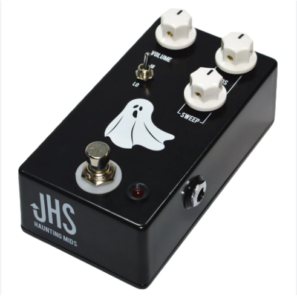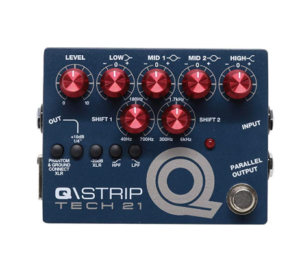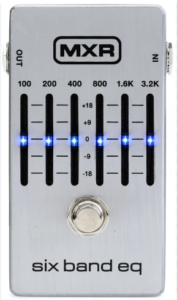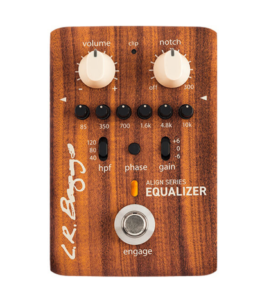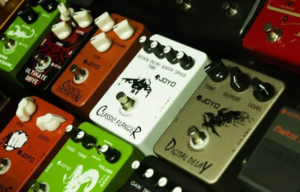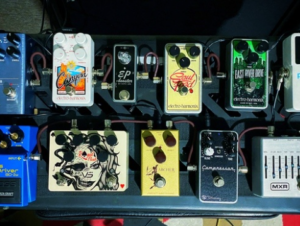If you’re playing an energetic set in front of many people in a basement, the crowd will forgive you for a little bit of mis-setting of your EQ or compression. Still, you shouldn’t overlook these tools as a way to enhance your tone.
When it comes to EQ pedals, using different EQ settings on different parts can make your sound louder, tighter, and more intense. Plus, most EQs have a master volume, so you can absolutely go louder if you need to.
Here, we take a look at the best EQ pedals and offer some buying advice to help you fine-tune your choice.
Top 8+ Best EQ Pedals for 2025
1. Empress ParaEQ MKII Deluxe
Featuring a true bypass, 30dB of boost, and a three-band parametric EQ, the Empress ParaEQ pedal.
Small enough to fit on most pedalboards, it has three parametric bands, high-pass and low-pass filters, and two shelving filters for high and low frequencies.
There’s also a boost on the second footswitch. That is, you effectively get a two-channel preamp, at least in terms of gain.
Parametric EQs are very common in studio applications, and the most common set of EQ actions for guitars is to apply two or three parametric bands and a high-pass and low-pass filter.
With the ParaEQ, you can do this kind of control live in a pedal format with a lot of headroom.
The non-deluxe version of the ParaEQ comes without the HP/LP and shelving filters.
However, if you’re spending that kind of money on an EQ, it’s worth it to have the extra filters. You’ll never need to buy another EQ again.
Because you can control the Q of the three main bands, this pedal can be subtle in terms of the EQ actions available. Plus, it has the depth to make it a useful studio tool for guitar, bass, or synthesizer.
2. JHS Haunting Mids
JHS Pedals Haunting Mids is a pedal that focuses on altering the character of your tone by changing the midrange frequencies.
This pedal started out as a Halloween joke, but due to popular demand, JHS has added it to their permanent lineup.
The Mids knob controls how much the midrange will be cut or boosted, with the neutral position at 12 o’clock providing 15dB of cut or boost on either side.
The Sweep knob determines which midrange frequencies will be boosted or cut between 250Hz and 7.5kHz.
Anything less than 12 o’clock will have a lower midrange, and anything greater than 12 o’clock will have a higher midrange.
The Hi/Lo toggle is a simple Q control, with Hi being a narrow frequency range and Lo being a wider curve for a smoother effect.
JHS claims that the midrange is the most important aspect of the sonic spectrum when it comes to perceiving a drive pedal, so this pedal may be more versatile than you initially think.
In fact, Haunting Mids can produce some really recessed rhythm tones and punchy lead tones with a booming midrange with this little pedal.
3. Q Strip Tech 21 EQ
The Q Strip from Tech 21 is one of my favorite EQ pedals for a number of reasons. It’s a vintage-style equalizer that offers virtually endless tonal possibilities.
Inspired by original recording consoles from the 60s and 70s, the Q Strip is my go-to pedal whenever I want to add warmth and intensity like those legendary consoles.
The board inside the pedal is hand-wired, with the utmost care taken in its design and construction. The Q Strip is essentially a direct input box comprised of MOSFET analog circuitry.
Like most of the Tech 21 lineup, it’s 100% analog. So if you’re looking for a digital pedal, this might not be the one for you.
I also wouldn’t call it the most user-friendly pedal, as it takes some getting used to the design and functionality.
But once you get used to it, it’ll become an essential tool that can completely freshen up your guitar’s tone.
Did we mention that the pedal features four studio-quality EQ bands? Each is inspired by a specific classic console module, and you can hear the definition instantly as you flip through the settings.
Meanwhile, the bands are split into two-parameter midrange and single treble and bass shelving filters, giving you complete control over the output.
There are also separate high-pass and low-pass filters that can be used to quickly shape the frequency response of your instrument.
Using the LPF in conjunction with the EQ section allows you to simulate different curves of a speaker cabinet and blend the results with other effects pedals.
The HPS is useful for cutting out low-end frequencies that sometimes cause problems when using filters or direct inputs to your instrument.
4. MXR M109S
The latest version of the MXR 6B has low noise, True bypass switching, and LEDs on the sliders, making it ideal for live use on dark stages.
Each active band offers a whopping 18dB of boost or cut, but there’s no master-level control. The bands start at 100Hz and go all the way up to 3.2kHz, so there’s no treble control.
However, most amps will likely have a shelving EQ that can add a little brightness if needed.
Most run it in front of the amp, but there’s also the option of running it in the effects loop. Here you can radically change the distortion tone for lead or rhythm use, much like the graphic EQ on a Mesa amp.
5. L.R. Baggs Align Series Equalizer
The L.R. Baggs Align Series Equalizer is made specifically for acoustic guitar players. The company based this EQ on their successful Para Acoustic DI.
This EQ features a FET gain stage and a 6-band EQ with a very wide bandwidth.
This pedal also features a variable high-pass filter and phase inversion. A Garret Null notch filter helps control resonant feedback.
If you’re looking for an acoustic guitar EQ from a trusted, acoustic-focused brand, check out this pedal.
6. Boss EQ-200
If you already love BOSS’ stompbox lineup, you will be amazed by the design and functionality of the EQ-200.
It is a very detailed pedal and in my opinion, it is best suited for those who have a clear idea of what EQ settings they want. It is also great for those who play multiple instruments.
The Boss EQ-200 is nothing more than a studio rack EQ in pedal form.
In fact, it’s more like a DAW graphic EQ than a graphic EQ in terms of functionality, complete with visual curves.
Considering the insert, it has a similar footprint to the Chase Bliss in terms of shaping the tone in front of the amp. However, it lacks a dedicated preamp.
Featuring dual 10-band EQs that can be run in stereo, parallel, or serial, it can accommodate wet-dry rigs and complex setups in a single pedal, with full MIDI control over the parameters.
Each band is active, with 15dB of boost or cut on tap, and the entire range covered by the band range is also customizable.
Finally, despite all the horsepower, there are some additional ergonomic features, including a customizable footswitch and the ability to disable the front panel controls to avoid live mistakes.
Overall, the BOSS EQ-200 is small but powerful in terms of sound-shaping capabilities. This graphic EQ pedal gives you complete freedom to shape the tone of your instrument.
With two independent 10-band EQ engines, you can store your favorite presets and access them at the press of a button.
7. J Rockett Melody EQ
As someone who loves overdriven guitar sounds, I was immediately drawn to the J.Rocket Audio Designs Melody OD 6-band EQ.
This clever overdrive pedal boasts tone adjustment capabilities, eliminating the need to purchase a separate EQ pedal to manage your tone.
So instead of having to buy multiple EQ pedals to adjust the frequency response of your wet/dry signal, you get the best of both worlds with this J.Rocket option.
The Melody OD delivers a warm, authentic overdrive that’s perfect for a variety of genres, including jazz, blues, and rock guitar.
I didn’t find the saturation levels to be too extreme. Instead, it helped add a bit of breakup to the tone, similar to how a valve is pushed to its limit in a tube amp.
Along with the high-quality overdrive capabilities this pedal offers, it also has a 6-band graphic EQ. With 18dB of boost or cut applied at each frequency, the sound gets even better.
Instead of being stuck with bands that you might not use, the brand has carefully selected only the frequencies that are most compatible with the overdrive tone produced by the pedal.
Plus, the true bypass switching does a great job of keeping the tone consistent.
8. MXR M108S
Featuring 10 independent sliders that cover carefully selected frequency bands, this graphic EQ boasts exceptional precision.
Each EQ slider on the MXR M108S can boost or cut by up to 12dB, leaving plenty of room for boosting or scooping.
The pedal lets you tailor the output of your instrument to suit the acoustic environment in which you’re performing.
For example, when testing and discovering bass traps in a room, I was able to easily eliminate some of the problem frequencies by adjusting one or more faders.
I also found the dual outputs to be a thoughtful addition, allowing you to split your wet and dry signals between two amps.
The pedal’s power allows it to operate at 18 watts, ensuring maximum headroom even when connecting multiple pedals to the M108S.
In addition to the frequency adjustment sliders, there are also volume and gain controls to keep levels consistent.
There’s also true bypass switching to maintain the integrity of your dry tone, and the pedal is housed in a solid aluminum housing, making it ready to withstand the rigors of touring, recording, and practicing.
FAQs
What type of EQ is there?
The two types of pedals you’ll encounter are graphic and parametric. Most guitar pedal EQs are graphic EQs, which means they have fixed audio bands that you can boost or attenuate.
These are usually controlled by sliders. Some digital effects allow you to set these bands directly, but analog pedals are fixed.
The second type, parametric, is when you have adjustable audio bands that you can control the Q or shape of. Typically, you’ll only see a single parametric band for the midrange in high-end EQs.
How many bands do I need?
The second main question is how many bands do I need? For parametric EQs, this is likely between 1 and 3. For graphic EQs, this is usually between 6 and 10 bands.
These are placed at frequencies that are an octave above the fundamental frequency.
A 3-band parametric EQ or a 5 or more-band graphic EQ will give you much more control over your tone than almost any guitar amp.
How does EQ affect my guitar tone?
As mentioned earlier, every sound (whether it’s heard alone or from multiple sources like a band) forms a sonic footprint. This sonic footprint is recorded as one by our ears.
How these different sources combine determines what we hear.
This is what really makes sound engineering an art. They have to make sure that all the different instruments occupy different spaces in the EQ spectrum and don’t overwhelm or sound sloppy.
This can be especially tricky for guitars, as they are a mid-range focused instrument that can often compete with other instruments in the same spectrum, such as saxophones, vocals, drum toms, and other guitars.
The mid frequencies are often occupied by these instruments, so you want your guitar to not a (disappear or b ) get too distracting in the mix.
You need to find that perfect little space, and this can be achieved by using an EQ pedal to shape the turn and place it in that space.
How to Use an EQ Pedal?
If you want your EQ pedal to be a utility pedal, use it sparingly. You can use it to create specific ‘effects’, like the AM radio tone you hear on the Strokes or the heavily swept midrange you hear on old Pantera records.
The beauty of EQ is that you can make small, subtle changes that can either perfectly shape your tone or extend the range of sounds you’re already getting from other pedals.
Or you can set the pedal flat (Everything to 0) and use the gain control as a boost for guitar solos.
You can also use an EQ pedal to boost or subtract specific frequencies, which is how you shape your sound.
Note: If you’re playing in a band, don’t set your EQ pedal alone. You don’t want to create a beautiful, holy grail guitar tone with your EQ only to have it disappear as soon as the band starts playing.
You might be surprised to learn that the sound you get when you EQ your guitar tone in a band mix might not be the sound you would choose when playing solo.
However, when playing with a band, it’s more important to sound good, so if you’re happy with what the band is playing, go for it. Trust your ears. They know what sounds good.
Do you need EQ on your amp?
Sometimes you do, sometimes you don’t. If you want more control over your signal, you do. EQ pedals often have sliders instead of knobs, which makes it easier to visualize what the sound will ‘look like’.
Your amp will have EQ controls, but they can change a wider range of frequencies, so an EQ pedal (especially one with 7 or more bands) can focus on those frequencies.
Conclusion
An EQ pedal is a very useful addition to your setup, giving you a platform to sculpt your tone with precision. It’s not as exciting as a fuzz or delay pedal, but it’s just as important, if not more so.
After reading this definitive guide to the best EQ pedals on the market today and the information section covering everything you need to know about the subject, you will now be in a position to make an informed choice.
Also read: Top 10 Best BluesBreaker Pedal


